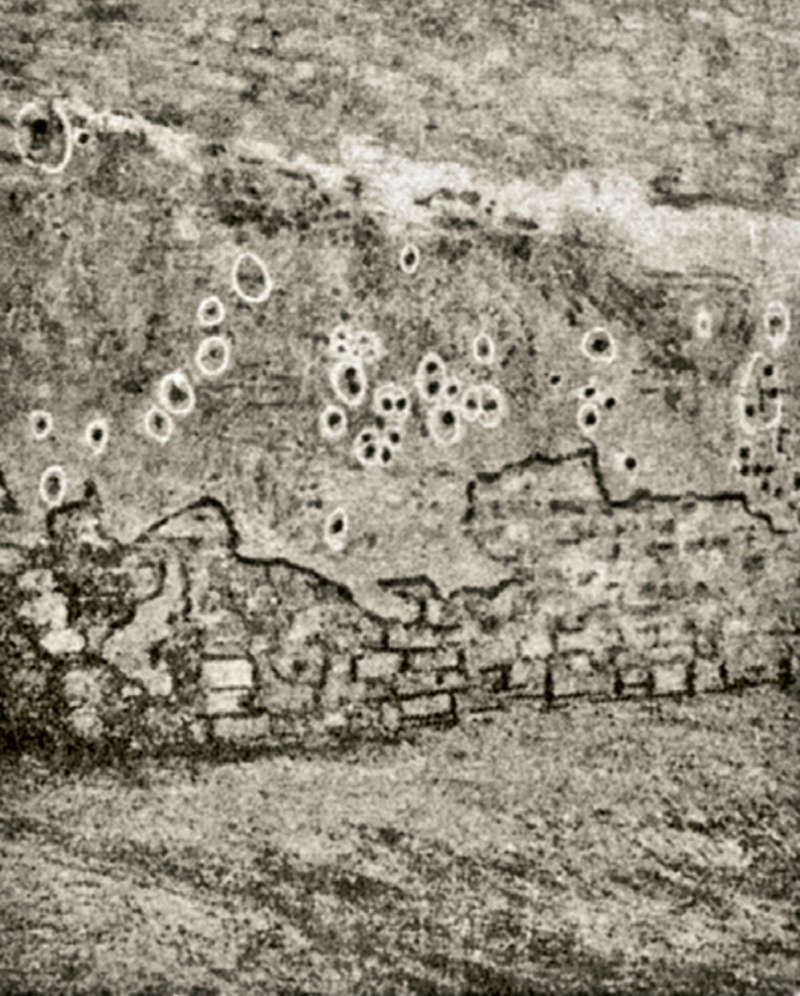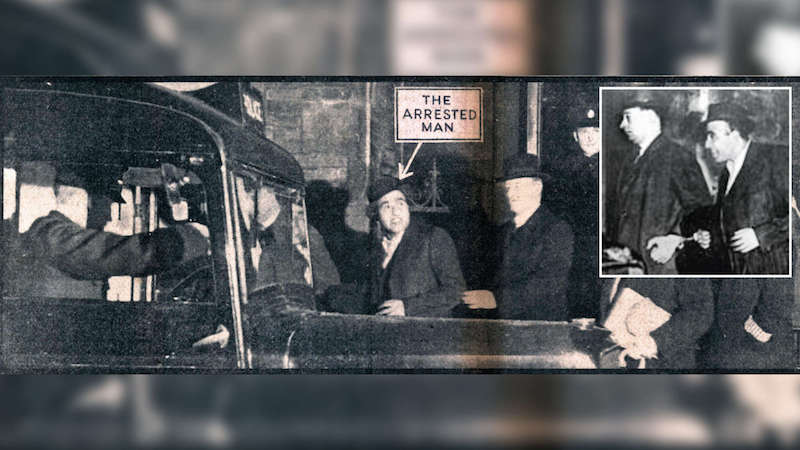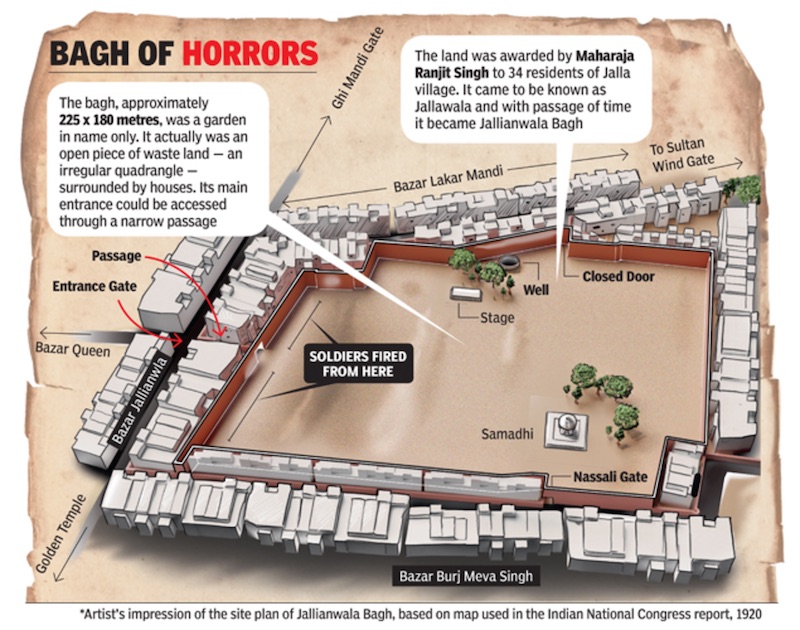The Jallianwala Bagh massacre
(Created page with "{| class="wikitable" |- |colspan="0"|<div style="font-size:100%"> This is a collection of articles archived for the excellence of their content.<br/> Additional information ma...") |
Revision as of 17:17, 9 April 2019
This is a collection of articles archived for the excellence of their content. |
The massacre, in brief

From: Yudhvir Rana, Vibhor Mohan, Naomi Canton, Kamal Preet Kaur and Sanjeev Verma, April 7, 2019: The Times of India

From: Yudhvir Rana, Vibhor Mohan, Naomi Canton, Kamal Preet Kaur and Sanjeev Verma, April 7, 2019: The Times of India

From: Yudhvir Rana, Vibhor Mohan, Naomi Canton, Kamal Preet Kaur and Sanjeev Verma, April 7, 2019: The Times of India
The Jallianwala Bagh massacre catalysed the Indian independence movement and gave it a new shape and momentum
Punjab, which experienced a series of great tragedies in the last century, will perhaps never forget the one that happened on the day of Baisakhi, April 13, 1919. The Jallianwala Bagh massacre, which came barely months after the Armistice on November 11, 1918 ended World War I in Europe, occurred as undivided Punjab was struggling and in ferment.
Undivided Punjab had contributed an enormous number of soldiers to the colonial government’s war effort — 3,55,000 combatants over four years of conflict. But the war- time sacrifices of Punjab were forgotten by the colonial rulers as demobilised soldiers from various fronts in Europe returned home to unemployment. To complicate matters further, crop failure meant there were food shortages and skyrocketing prices.
The British began to feel cornered as Indian independence leaders called for peaceful protests against the draconian Rowlatt Act. The prelude to the Jallianwala Bagh shooting was a complete hartal in Punjab on April 6, which the Indian National Congress described as “spontaneous and voluntary,” against the Rowlatt Act. But what started as a peaceful strike was followed by large-scale violence. “Had the massacre not taken place on April 13, everyone would have been talking about the violence of April 10, when about 20 people were killed while crossing a railway bridge that led to the British parts. The crowds then went wild and four to five Europeans were killed. That was when Miss Sherwood, an unarmed English missionary, was beaten up,” says Amandeeep Singh Madra, a historian.
This outbreak of violence shook the British. “Brigadier-general Reginald Dyer, the third officer sent to Amritsar in 48 hours, was asked to take a tough stand. It came as the British were panicking and feeling overrun. He was not a crazy guy who did things on his own. There was concern about unrest. Indian nationalists were protesting British policies and were seen as seditious, so two leaders were arrested,” says British historian Kim Wagner.
A large number of people — estimates vary between 5,000 and 20,000 — gathered at Jallianwala Bagh on the day of Baisakhi. “The mood was somber and fear was writ large on their faces as people felt trapped inside the city. Every exit was guarded and it was impossible for anyone to leave without permission. Even those who considered themselves close to the British felt the sudden freezing-up of the relationship,” says Kishwar Desai, who has written a book on the killings.
A century later, no clarity on number of martyrs
Despite memorials, commemorations, and books, a complete list of those killed at Jallianwala Bagh has not been published, or displayed, thus far. The tragedy has been that one hundred years later all the lists individually appear to have some lacunae or are incomplete.
There has always been a problem in identifying and collecting names of those killed at Jallianwala Bagh. Initially, this was because the meeting at the Bagh was very large though eyewitness accounts varied between 5,000 and 30,000 or more. Eyewitnesses subsequently remembered that the dead strewn across the Bagh would have been more than 1,000. Given that 1,650 rounds were fired in a closed area — 1,000 casualties and many more injured seems very feasible...
Jallianwala Bagh was a garden only in name. It actually was a plot of waste land, an irregular quadrangle surrounded by houses. It was, at the time, a private property owned in common by several people. The main entrance could be accessed by a narrow passage. At four or five points, it was possible to get out through these.
Dyer arrived at the Bagh with 50 soldiers, armed with .303 Lee–Enfield bolt-action rifles. Others had knives or khukris. His team fired 1,650 rounds in about 10 minutes, stopping only when they ran out of ammunition. He made no effort to provide medical aid to the wounded, saying it was not his duty and left the scene of devastation.
What Dyer said in his report on August 25, 1919
I fired and continued to fire till the crowd dispersed... if more troops has been at hand, the casualties would have been greater in proportion. It was no longer a question of merely dispersing the crowd, but one of producing a sufficient moral effect... not only on those who were present, but, more especially throughout Punjab
A fallout of Dyer’s indiscriminate firing on the crowd was that British forces were forbidden to fire on civilians afterwards, says British historian of Indian origin Zareer Masani. “So, even during the Partition riots when mobs were killing each other the British Indian Army did not intervene because it was forbidden. There were no particular rules before the massacre that forbade it from opening fire on civilians.”
The senseless violence catalysed the Indian independence movement and gave it a new shape and momentum. It also gave impetus to the Gurdwara Reform Movement, what with Dyer being honoured by the mahant of the Golden Temple with a siropa and declared a Sikh just after he had butchered hundreds of innocents.
The incident itself may have later been overshadowed by the devastation caused by Partition, but the massacre is still an emotional issue for Punjabis.
UDHAM SINGH, THE MAN WHO AVENGED THE MASSACRE
Udham Singh shot dead Sir Michael O’Dwyer at a meeting of the East Indian Association in London on March 13, 1940. His murder trial lasted two days
A day after Sunam-born Ghadar Party revolutionary Udham Singh shot dead Sir Michael O’Dwyer, former lieutenant governor of British Punjab, in a meeting of the East Indian Association at Caxton Hall in London, UK’s Daily Mirror on March 14, 1940, carried a banner headline, ‘Assassin shoots minister, kills knight’.
O’Dwyer was at the helm of affairs in undivided Punjab under British rule during the Jallianwala Bagh carnage and had supported ‘General’ Reginald Dyer ordering firing on unarmed civilians.
Udham Singh, dressed in an overcoat and a hat, fired several shots, leaving Lord Zetland, secretary for India; Lord Lamington, a former governor of Bombay and Sir Dane, former governor of Punjab, wounded. He was overpowered and arrested on the spot.
The Hull Daily Mail of the same day reported, “Mohamed Singh Azad... believed to be a 37-year-old Indian appeared at Bow Street, London today, charged with the murder of Sir Michael O’Dwyer... As he entered the building, Azad was smiling and chatting to the officers who accompanied him...’’
His name and religion caused some confusion. Initially, charged in the name of Mahommed Singh Azad, it was later discovered that the name in his passport was Udham Singh. His statement recorded after the incident and produced as evidence carried in Daily Mirror report on April 2, 1940, said, “Ready to die, says Indian... I am dying for my country.”
The murder trial lasted two days, June 4-5. Interestingly, when Udham Singh was brought to court for trial, he pleaded ‘Not Guilty’.
On June 5, the prosecution questioned Udham Singh before the case was summed up and the Jury unanimously pronounced him guilty of murder. An appeal filed on his behalf on June 24, citing inadequate defence before the jury, was turned down. He was executed in Pentonville Prison, London, on July 31, 1940.
TRANSCRIPT OF THE HIGHLIGHTS FROM THE TRIAL
“Prisoner at the Bar, you stand convicted of murder. Have you anything to say why the court should not give you judgment of death according to law,” the clerk asks Udham Singh in the court of Justice Atkinson at Old Bailey, London, on June 5, 1940. It’s just after 4 pm and the jury has unanimously found Udham Singh guilty of the murder of former Punjab lieutenant-governor Sir Michael Francis O’Dwyer after a trial that began the previous day on June 4, making it perhaps one of the shortest trials in the history of Old Bailey.
According to court records of the case, transcript of the shorthand of trial accessed by the TOI at British Library, Udham Singh responded, “Yes Sir, I have a statement. I say down with British Imperialism in India and let us have peace. Read your own history. You have had many inhuman monsters, cold blooded and bloodthirsty who have been the rulers of India...”
However, Justice Atkinson intervenes, “I am not going to listen to a political speech”. He asks Udham to pass the note from where he’s reading. Justice Atkinson: “Is that written in English?”
Udham Singh: “Yes.”
Justice Atkinson: “I shall understand it much better if you will hand it to me to read.”
Udham Singh: “No, I want it myself. Not for you.”
Justice Atkinson: “I cannot make out what you are saying.” Udham Singh: “Who will read it?”
Justice Atkinson: “I will read it.”
Udham Singh: “I want the jury and the whole lot to read it.”
McClure (counsel for prosecution): May I remind your Lordship that there are powers under the emergency powers of the Defence Act which enable your Lordship in any case to hear things in camera. ...
Justice Atkinson: You may take it that nothing will be published of what you say...
Udham Singh: I did it to protest and this is what I mean. I want to explain. The jury was misled about the address. Shall I read it now?
Justice Atkinson: Yes, get on with it.
Udham Singh: I should like to read the lot, you know.
Justice Atkinson: You are only entitled to say anything ...why sentence of death should not be passed upon you. You are not entitled to make a political speech.
Udham Singh: I don’t care about dying... May I still read it?
Justice Atkinson: Say anything you have got to say to the point, but as far as I could hear you began by denouncing the British government or the British Empire, and we are not going to have that here. That is nothing to the point.
Udham Singh: I am not afraid to die. I am proud to die. I want to help my native land, and I hope when I have gone that in my place will come some others of my countrymen to drive the dirty dogs... when I am free of the country. I am standing before an English jury in an English court. You people go to India and when you come back you are given prizes and put into the House of Commons, but when we come to England are put to death. In any case I do not care anything about it, but when you dirty dogs come to India... the intellectuals, they call themselves, the rulers... and they order machine guns to fire on the Indian students without hesitation ... (inaudible)... killing, mutilating and destroying. We know what is going on in India --- hundreds of thousands of people being killed by your dirty dogs.
Justice Atkinson: I am not going to hear any more of this so you can put this paper away. I am going to pass sentence upon you. Udham Singh: You do not want to hear anymore. I have to say a lot.
Justice Atkinson: I am not going to hear any more of that, but if you have anything relevant to say...
Udham Singh: You people are dirty. You don’t want to hear from us what you’re doing in India. Beasts, beasts, beasts. (Proclamation)
Udham Singh: England, England, down with Imperialism, down with the dirty dogs.
Justice Atkinson then passed the sentence of death...
